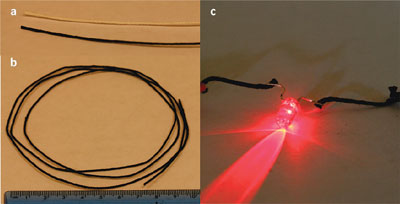| Posted: December 3, 2008 |
Clothing with a brain: Smart fabrics that monitor health |
|
(Nanowerk News) Researchers in United States and China are reporting progress toward a simple, low-cost method to make smart fabrics, electronic textiles capable of detecting diseases, monitoring heart rates, and other vital signs. A report on these straight-out-of-science-fiction-fibers, made of carbon nanotubes, is scheduled for the December 10 issue of ACS’ Nano Letters.
|
|
In the new study, Nicholas A. Kotov, Chuanlai Xu, and colleagues point out that electronic textiles, or E-textiles, already are a reality. However, the current materials are too bulky, rigid, and complex for practical use. Fabric makers need simpler, more flexible materials to make E-fibers practical for future applications, they say.
|
 |
| Photographs of CNT-cotton yarn. (a) Comparison of the original and surface modified yarn. (b) 1 meter long piece as made. (c) Demonstration of LED emission with the current passing through the yarn. (Reprinted with permission from American Chemical Society)
|
|
The scientists describe development of cotton fibers coated with electrolytes and carbon nanotubes (CNT) — thin filaments 1/50,000 the width of a single human hair. The fibers are soft, flexible, and capable of transmitting electricity when woven into fabrics. In laboratory tests, the researchers showed that the new E-fibers could light up a simple light-emitting diode when connected to a battery. When coated with certain antibodies, the fibers detected the presence of albumin, a key protein in blood — a function that could be used to detect bleeding in wounded soldiers. The fabrics could also help monitor diseases and vital signs, they say.
|
|
Also, read our Nanowerk Spotlight "Nanotechnology e-textiles for biomonitoring and wearable electronics" about this work.
|

